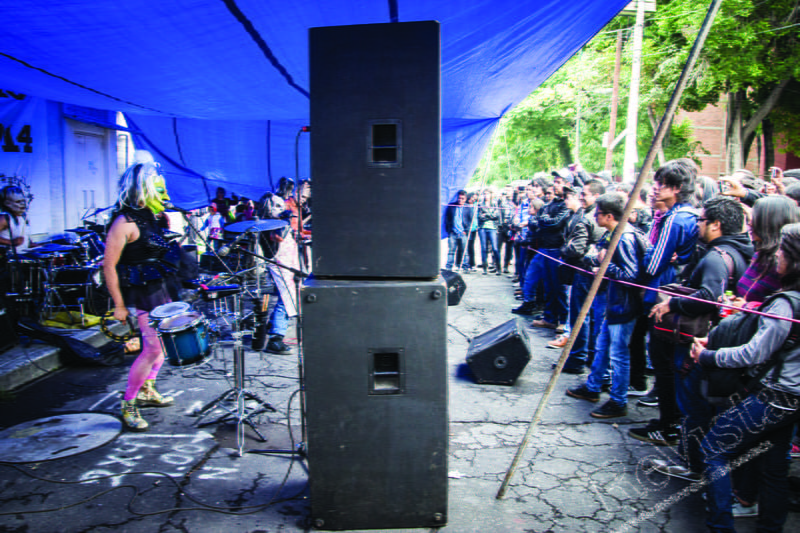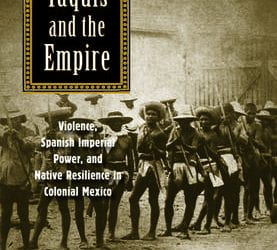Notes on Mexican Rock
Through the Lens of El Chopo

Photographer Carin Zissis captures the style and flair of rock concert fans who go to El Chopo to listen to music and to buy CDs, albums, musical instruments and other merchandise.
Since the 1960s, there’s been a booming underground rock scene in Mexico. It defines itself as countercultural, but not in absolute opposition to the mainstream—although sometimes it indeed is. Rather, the underground rock scene developed to seek inclusion in the midst of political and economic backwardness. It was and still is also a way of resisting the strict yet worn imposition of official values carried out by the state since the Mexican Revolution.
Rock, like other social phenomena, includes “simulations of social interactions,” as Laura Martínez Hernández, following Néstor García Canclini, points out in Music and Alternative Culture (p. 29). In this way, the Mexican underground rock scene—beyond its musical quality which is much criticized by specialists like Hugo García Michel—needs to be looked at as a parallel construction of the Mexican identity, this time, however, one that is elaborated from the periphery. The stories told by rockeros make them visible, and in the process manage to show what the status quo promotes and what it renders invisible and even causes to disappear. The Institutional Revolutionary Party (PRI), a hegemonic party that has controlled Mexico’s political system for many decades, produces and successfully imposes an unambiguous construction of a national identity of a country that has left behind the era of social injustice for a new age of development. The still current triumphalist discourse generated by those in power suffered its first great rupture in the 1960s, when the first economic crises began to affect large sectors of the population. People began to react to the political erosion and the consequent and increasingly authoritarian and censorial attitudes of a party that could no longer sustain the illusion of being an agent for democracy and social equity.
The first years of rock in Mexico demonstrated the capacity of the power structures of the authoritarian state and media to control and manage culture. Facing the inevitable advent of rock and roll, the system responded not so much by rejecting but by absorbing it and taking away any dissident undertones. Among other strategies for exerting cultural—and with it, political—control, the PRI systematically created a media strategy in which the decision was not to nationalize the media, but to give it over to entrepreneurs who had ties to the government. In this way, in 1955, precisely during the birth of rock and roll, the first—and for many years, the only—private television company, Telesistema Mexicano (which would later be called Televisa, and whose owner named himself a soldier of the PRI in a polemical interview), was established. The television station, whose scope gradually extended to all sorts of musical shows, radio stations and movie productions, acted during the first years of the rock phenomenon as a filter that let in those aspects of the new musical movement that aligned with the official interests of the time, in this way getting rock to lose its subversive capacity and become a model of the modernity it was entering. Including this musical novelty was even considered a gesture of democratic acceptance of the new phenomenon that some conservatives accused of being a foreign threat to the national identity. The system, however, was prepared to neutralize these and other attacks. The Mexican media managed to control the phenomenon during its first years, making space for politically correct musical groups and singers, who then turned into soap opera and sitcom stars. Covers and bands that were noticeably copied from bands in the United States—even in their skin tones— dominated in this initial period. The Teen Tops, the Locos del Ritmo or the Rebeldes del Rock allowed Mexican youth at the end of the 50s and beginnings of the 60s to get the eternal adolescent sensation of the modern and the different with a light touch of rebellion. The initial mainstream strategy continued during the following decades. It was only well into the 80s, when the underground movement was unstoppable, that transnational record companies first attempted to promote artists under the slogan “Rock in your language,” selecting groups that were more or less independent yet still followed the same old initial model: white artists who catered to the apolitical middle class, with fundamentally romantic songs and rhythms that were more sophisticated yet still very close to pop.

The audience listening to this rock concert in El Chopo are fans who often carry backpacks with used CDs they sell or trade for other CDs and concert admission. Photo by Carin Zissis.
Nevertheless, this type of commercial rather than musical policy never satisfied a generation of youth who began to understand that rock was a transversal phenomenon that went beyond what the national media allowed. Thus a musical scene emerged, mainly in the outlying neighborhoods of large urban areas like Guadalajara, Monterrey, Tijuana or Mexico City, which was subsequently attacked for decades by classist and nationalist critics who disqualified it and shut all doors to this sort of music. This second reworking of rock in the 60s left behind the covers sung in Spanish and proposed new lyrics that were often sung in English as a way of returning to the origins and separating itself from the rock that dominated radio and television stations. A vast number of groups emerged; some of them did not hide their political militancy while they adapted and Mexicanized rock. Their names said it all—as direct allusions to the Mexican Revolution—showing that the appropriation of the national promoted the revolutionary myth along with the PRI: La Decena Trágica (The Tragic Ten Days), División del Norte (Division of the North), and especially, La Revolución de Emiliano Zapata (The Revolution of Emiliano Zapata). This last group’s story is as sad as it is symptomatic of what happens in Mexico. Their song, “Nasty Sex” (1970), had reached beyond Mexican borders and acquired a certain prestige, but in the end the system asphyxiated their impetus and impeded their economic survival, for which they sold their rock soul for the romantic ballad.
These and other underground Mexican groups, plus the global and local contexts of the turbulent 60s, created the surge of a youthful social phenomenon known as the Onda, which went beyond rock but cannot be understood without it. Those involved in the Onda, called jipitecas (a mix of hippie and Aztec) became one of the first youth-centered urban and suburban configurations that, beginning in the 80s, formed part of the Mexican scene. In a book essential for the understanding of Mexican culture in the 20th century, Lost Love, Carlos Monsiváis cannot resist dedicating a large chapter to the subject where he writes: “The Onda is the first movement of contemporary Mexico that refuses institutional conceptions from non-political positions and, with eloquence, reveals to us the extinction of a cultural hegemony. The jipitecas anticipate and sum up a process: in rejecting nationalism, they resolve, without major theoretical effort, the construction of options. The first aim is the mocking of Unappealable Social Goals, the objectives for which their fathers have lived. The monopoly on the perception of reality is mocked” (p. 235, emphasis his). Monsiváis here points out what is perhaps the principal contribution of the Mexican underground rock movement extending beyond the Onda: its capacity to create a sort of mirror that reflects a distinct and disillusioned image of the country, one that contradicts the political and media discourse, not by directly denouncing it as protest music, cinema or militant literature does, but by creating a meta-narrative in which previously hidden social entities become the protagonists, including the creative subjects themselves who promote themselves as the model for the downfall of the system. The figure of the Gramscian subordinate emerges once more, just as other local archetypes had in the past, like the low-class boor (or churl) featured in Roger Bartra’s classic text, The Cage of Melancholy. The rocker takes various elements from the figure of the churl, among them a new sense of popular and local language: “Ya chole, chango, chilango.” (“Hey dude, stop it!”). Mexican rock also constructs a Mexico City not represented by other artists: a city of rats, housing projects, bank robberies and stray dogs mowed down recklessly by cars, but also a city with neighborhood beauty queens, student cantinas and subway stations where urban life takes place.
Perhaps the only organized rock movement in the country emerged in Mexico City beginning in the 80s. The Rupestre Movement started not only as a counter-offensive against mainstream music, but also in contrast to Cuban nueva trova and Andean music that was dominant primarily among the middle class youth in universities, who found a new continental form of resistance in the Hispanic American identity of the 70s. A great many young people did not feel represented in this expression and called for a more direct and more local music that diverged from the melodic sweetness of Cuba’s Silvio, or the national folklore of Mexicans such as Óscar Chávez or The Folkloristas, or the radical militancy of León Chávez Teixero. The Rupestres created their own spaces, organized concerts and promoted artists. They even wrote a manifesto that showcased the subordinate figure, now adapted to Mexico City’s urban culture: “It isn’t that the rupestres have escaped from the old Museum of Natural Sciences, nor from the Museum of Anthropology; neither have they come from the hidden hills in a truck full of chickens and beans. This is simply about everyone who isn’t very handsome, doesn’t have a tenor voice, doesn’t compose like the heights of aesthetic knowledge, or (even worse) doesn’t have the sophisticated electronic equipment and crazy effects that impress the first scatterbrain who hears it” (excerpt from the Rupestre Manifesto). The Rupestres don’t appeal to either political or social labels, it’s enough for them to show the disillusionment of a generation that has left behind the rural world of the mid-20th century, entering into a Mexican modernity that has no hope of social ascent, but is willing to fight the creative fight to occupy a space in it.
After more than three decades of emerging, and despite being lauded by homages and documentaries about them (one has just come out on YouTube: Rupestre, the Documentary), the members of this movement are practically unknown by the majority of the Mexican population, which implies that their marginal condition still prevails. Among them, one iconic figure stands out—perhaps the only one in the history of Mexican rock. This is Rodrigo González, also known as Rockdrigo or the Prophet of the Cactus, both nicknames he invented. September 2015 marked the 30th anniversary of his death in the 1985 earthquake, which ended the Rupestre movement. However, with a first album that he himself produced and sold (Hurbanistorias, 1985), and others posthumously created from loose recordings, Rodrigo is still being heard and valued by a sector of the population beyond Mexico City, as seen in the 2013 documentary, Who Is Dayani Cristal? in which Central American immigrants aboard the train known as The Beast sing one of his songs from memory even better than Gael García Bernal did.
Like Rockdrigo, the Mexican underground rock movement has been able to organize and manage its own marketing and distribution during times when globalization and the free market were absent. The Rupestre movement rests on the support of the National Autonomous University (UNAM) and other spaces funded by, yet independent from, the state, like Education Radio. At UNAM, the Rupestres find modest support from the Chopo Museum, which organizes concerts and disseminates their music. In 1980, the Chopo Museum began to allow a music street market by the same name to flourish in front of its premises, but when the market began to become highly popular and expand, it moved to a street close to the enormous PRI headquarters, a surreal vision of the official and the countercultural convening in one point in Mexico City. The Chopo street market did not get started thanks to the democratic opening of the party in power, but rather in spite of its opposition. The vendors who sell here, today rockerograndfathers in T-shirts and white beards, began to offer music that was impossible to obtain elsewhere in the 80s. Their success has been such that the street market has become a space of tolerance where the police cannot intervene, under the condition that the vendors will be responsible for security, a responsibility carried out with even greater success than the authorities have had, resulting in a safe space that is entirely devoted to the sale of music (yes, much of it pirated, but how else would one acquire a German heavy metal album in Mexico in the 80s?). There, one can also find booksellers, movie stands, tattoo artists, musical instruments and other paraphernalia related to rock. Its fame has brought artists and intellectuals who give concerts or participate in a variety of activities to support and promote the market.
As the reader may deduce from these notes, Mexican rock is a political endeavor without directly trying to be one. Its simple discourse based on binary opposites has allowed for the idea of an alternative country, not for the purpose of following the sometimes naïve rock utopias, but to refuse the idea of a single path for the construction of national identity during a time when no one shouted as loud as they did, even though few listened. Its musicians’ initiatives used creativity to break the country’s media and marketing monopoly bubbles, which was no small feat during the years in which social repression and censorship reigned with no social networks to denounce them. Today, with a new authoritarian temptation in Mexico, a return to these Rupestres is advisable.
Algunas notas sobre rock mexicano
Por Humberto Delgado
Similar a lo que acontece en otras naciones, a partir de la década del 60 emerge en México una escena de rock underground que se proclama como contracultural, no entendido este concepto como una oposición absoluta a lo mainstream, aunque a veces sea el caso, sino como la búsqueda de la inclusión ante el atraso político y económico que comienza a sufrir el país y también como resistencia ante la imposición férrea pero desgastada de valores oficiales que lleva a cabo el Estado después de la Revolución Mexicana.
Siguiendo a Néstor García Canclini, Laura Martínez Hernández, en Música y cultura alternativa,señala que en el rock, como en otros fenómenos sociales, se elabora un espacio de “simulacros de las relaciones sociales” (p. 29). De esta forma, la escena underground mexicana, más allá de su calidad musical, muy criticada por algunos especialistas como Hugo García Michel, se vuelve un fenómeno necesario de analizar toda vez que allí se observa una representación paralela de la identidad mexicana, pero esta vez construida desde la periferia, relatos que no sólo hacen visibles a los grupos humanos que los elaboran, sino además logra mostrar lo que el status quo promueve, invisibiliza e incluso busca desparecer. No debe olvidarse que el Partido Revolucionario Institucional (PRI), partido hegemónico que ha controlado el sistema político mexicano durante el siglo XX y parte del XXI, elabora e impone con éxito una construcción identitaria nacional unívoca en el que se genera la idea de un país que ha dejado atrás las épocas de injusticia social para dar paso a un nuevo periodo desarrollista. El discurso triunfalista (incluso hasta el día de hoy) generado desde el poder sufre su primera gran fractura en los 60s cuando las primeras crisis económicas comienzan a afectar a amplios sectores de la población, quienes además atestiguan el desgaste político y la consecuente actitud autoritaria y censora cada vez más agresiva de un partido que ya no puede sostener la idea de ser un gestor de la democracia y la equidad social.
Un poco antes de este momento, los primeros años del rock en México son una prueba de la capacidad de control político y manejo de las redes de poder y medios que cuidadosamente construye el Estado autoritario. Ante el inevitable advenimiento del rock and roll, el sistema responde no tanto rechazándolo sino absorbiéndolo y quitándole cualquier tufo disidente. Entre otras estrategias para llevar a cabo un control de la cultura y con ello de la política social, el PRI crea sistemáticamente una estrategia de medios en el que la decisión no fue estatizarlos sino otorgárselos a empresarios afines al gobierno. De esta manera, en 1955, justo en los años del nacimiento del Rock and Roll, nace la primera y durante muchos años única empresa televisiva privada, Telesistema Mexicano, que más tarde se llamaría Televisa y cuyo dueño se autonombró soldado del PRI en una polémica entrevista. La televisora, que gradualmente extiende su poder a todo tipo de espectáculos musicales, estaciones de radio y producción de cine, funcionó durante los primeros años del fenómeno del rock como un filtro que dejó pasar aquellos aspectos del nuevo movimiento musical que convenían a los intereses oficiales en turno, perdiendo su capacidad subversiva y convirtiéndose en un modelo de la modernidad al que se estaba entrando. Incluir esta novedad musical fue incluso considerado un gesto de apertura democrática ante el nuevo fenómeno que algunos nacionalistas trasnochados acusaban de ser una amenaza extranjera a la identidad nacional. No había problema pues el sistema estaba preparado para neutralizar ese y otros embates. La media mexicana logra controlar el fenómeno durante sus primeros años, dando cabida a grupos musicales y cantantes políticamente correctos, que se transformaron luego en estrellas televisivas de telenovelas y sit coms. En este primer periodo dominan los covers y los grupos notoriamente calcados de grupos estadounidenses, incluido su tono de piel. Los Teen Tops, los Locos del Ritmo o los Rebeldes del Rock permitían a las juventudes mexicanas de finales de los 50s e inicios de los 60s adquirir la eterna sensación adolescente de lo moderno y diferente con un ligero toque de rebeldía. La estrategia inicial continúa durante las décadas posteriores. Es hasta muy avanzados los años 80s, cuando el movimiento underground es imparable, que comienzan los primeros intentos de las disqueras transnacionales de promover artistas bajo el concepto “Rock en tu idioma”, seleccionando grupos más o menos independientes pero siguiendo el mismo viejo modelo inicial: artistas blancos que proponen un modelo para la clase media apolítica, canciones fundamentalmente románticas con ritmos más sofisticados pero muy cercanos al pop.
Sin embargo, este tipo de políticas comerciales más que musicales nunca dejó satisfechos a una generación de jóvenes que empezaron a comprender que el rock era un fenómeno transversal que iba más allá del que la media nacional les imponía. Surge así, principalmente en los barrios periféricos de las grandes urbes como Guadalajara, Monterrey, Tijuana o la Ciudad de México una escena musical que durante décadas fue atacada por un discurso clasista y nacionalista que lo descalifica y le cierra las puertas. Esta segunda refundación del rock que inicia en los años 60s dejaba atrás los covers cantados en español y proponía letras originales que muchas veces fueron cantadas en inglés como una manera de regresar a los orígenes y separarse del rock que dominaba estaciones de radio y televisión. Surgen infinidad de grupos, algunos de ellos no esconden cierta militancia política al momento de adaptar y mexicanizar el rock, sus nombres lo dicen todo, ya que son alusiones directas a la Revolución Mexicana, mostrando que la apropiación de lo nacional propiciaba el mito revolucionario y le hacía el juego al PRI: La Decena Trágica, División del Norte y, muy en especial, La Revolución de Emiliano Zapata. La historia de este último grupo es tan triste como sintomática de lo que pasa en México. Su canción “Nasty Sex” (1970) logra repercusión más allá de las fronteras mexicanas y adquieren cierto prestigio, pero la asfixia provocada por el sistema les impide vivir económicamente de su obra, por lo que venden su alma rockera a la balada romántica.
Estos y otros grupos del underground mexicano, más el contexto mundial y local de los turbulentos años 60s, hacen que surja un fenómeno social juvenil conocido como la Onda, que va más allá del rock, pero que no puede entenderse sin éste como su columna vertebradora. Los participantes de la Onda, los llamados jipitecas (mezcla de hippie y azteca) se convierten en uno de los primeros fenómenos de conformación de grupos urbanos y suburbanos juveniles que a partir de los 80s forman parte del paisaje humano mexicano. En un libro fundamental para conocer la cultura mexicana del siglo XX, Amor perdido, Carlos Monsiváis no puede dejar de dedicarle un amplio capítulo al tema: “La Onda es el primer movimiento del México contemporáneo que se rehúsa desde posiciones no políticas a las concepciones institucionales y nos revela con elocuencia la extinción de una hegemonía cultural. Los jipitecas anticipan y resumen un proceso: al renunciar al nacionalismo se proponen, sin mayores afanes teóricos, la construcción de opciones. Lo primero es la burla de las Metas Sociales Inapelables, los objetivos y las cumbres por los que sus padres han vivido. Se ridiculiza una vía monopólica de aprehender la realidad” (p. 235, el subrayado es de él). Monsiváis señala en esta cita lo que es tal vez el principal aporte del movimiento underground rockero en México más allá de la Onda: su capacidad de crear un país paralelo, especie de espejo que refleja una imagen distinta y desencantada del país, que contradice el discurso político y mediático, no denunciándolo directamente como lo hace la música de protesta, el cine o la literatura militante sino creando un metarelato en el que son protagonistas entes sociales hasta entonces escondidos, incluidos los propios sujetos creativos que se autoproponen como modelo del fracaso del sistema. La figura del subalterno gramsciano surge de nuevo, tal como habían surgido años atrás otros arquetipos locales, como el lépero o peladito al que hace referencia Roger Bartra en su clásico texto La jaula de la melancolía. Del lépero, el rockero toma varios elementos, entre ellos el gestar un nuevo sentido del habla popular y localista: “Ya chole, chango, chilango”
De entre la mucha actividad rockera que surge en México a partir de los 60s, emerge el que tal vez es el único movimiento organizado de rock en el país. Se trata del Movimiento Rupestre que comienza en los años 80s en la Ciudad de México, surgido no sólo como contraofensiva contra la música mainstream sino también en contraposición a la nueva trova cubana y la música andina, dominante entre los jóvenes, principalmente entre la clase media universitaria que encontraban en la identidad hispanoamericana una nueva forma continental de resistencia a partir de los años 70s. Un amplio sector juvenil no se sentía tampoco reconocido en esta construcción y apelaban por un discurso más directo, mucho más local y que se alejara de la melosidad melódica del cubano Silvio, o del folclor nacionalista de los mexicanos Óscar Chávez o Los folkloristas o de la militancia radical de León Chávez Teixeiro. Los Rupestres crean sus propios espacios e incluso escriben un manifiesto que no deja de apelar a la figura del subalterno, adaptado ahora a la cultura urbana del DF: “No es que los rupestres se hayan escapado del antiguo Museo de Ciencias Naturales ni, mucho menos, del de Antropología; o que hayan llegado de los cerros escondidos en un camión lleno de gallinas y frijoles. Se trata solamente de un membrete que se cuelgan todos aquellos que no están muy guapos, ni tienen voz de tenor, ni componen como las grandes cimas de la sabiduría estética o (lo peor) no tienen un equipo electrónico sofisticado lleno de sinters y efectos muy locos que apantallen al primer despistado que se les ponga enfrente.” (Fragmento del Manifiesto Rupestre). Los Rupestres no apelan a lo político ni a la propuesta social, les basta con mostrar el desencanto de una generación que ha dejado atrás el mundo rural de mediados del siglo XX, entrando a la modernidad mexicana sin esperanzas de ascenso social, pero dispuesto a dar la batalla creativa por ocupar un espacio. La construcción de una ciudad de México bastante negada por otros artistas. Una ciudad de ratas, projects, perros callejeros aplastados por autos, asaltos bancarios, pero que no deja de incluir a la guapa del barrio, la cantina de estudiantes o las estaciones de metro donde transcurre la vida urbana.
Después de más de tres décadas de haber surgido y a pesar de que actualmente han gozado de homenajes e incluso hay un documental sobre ellos que se acaba de estrenar en Youtube (Rupestre, el documental), los miembros de este movimiento son prácticamente todavía desconocidos por el grueso de la población mexicana, lo que implica que su condición de marginales sigue sanamente vigente. De entre ellos, debe destacarse una figura icónica, la única tal vez que ha surgido de la historia del rock mexicano. Se trata de Rodrigo González, también conocido como Rockdrigo o el Profeta del Nopal, ambos nicknames creados por él mismo. En septiembre de 2015 se cumplen 30 años de su muerte en el terremoto de 1985, evento que cancela el movimiento rupestre. Sin embargo, con un primer disco producido y vendido por él mismo (Hurbanistorias, 1985) y otros más que después de su muerte se crearon a partir de grabaciones sueltas, Rodrigo sigue siendo escuchado y valorado por un sector de la población más allá de la Ciudad de México, como se puede ver en el documental del 2013, ¿Quién es Dayani Cristal?, donde inmigrantes centroamericanos a bordo del tren conocido como La Bestia cantan de memoria una de sus canciones, incluso mejor que Gael García Bernal.
Como Rockdrigo, el movimiento underground mexicano también ha sido capaz de organizarse y autogestionar su propio marketing y distribución en épocas donde la globalización y el libre mercado se encontraban todavía ausentes. El movimiento rupestre cuenta con el apoyo de la Universidad Nacional y de otros espacios financiados por el Estado pero independientes, como Radio Educación. En la UNAM, los Rupestres encuentran un modesto apoyo por medio del Museo del Chopo, que les organiza conciertos y difunde su música. El Chopo, también durante los 80s, auspicia un tiangis de venta de música los sábados, que actualmente se pone a unas cuadras del enorme edificio sede del PRI, en una surreal visión de lo oficial y lo contracultural conviviendo en un punto de la Ciudad de México. El tiangis del Chopo no surge gracias a la apertura democrática del partido en el poder sino a pesar de su oposición que varias veces ha tratado inútilmente de cerrar este espacio. Los comerciantes que venden allí, hoy abuelos rockeros de camisetas negras y barbas blancas, empiezan a principios de los ochenta a ofertar música inconseguible por otras vías. Con el paso de los años su éxito es tal que se vuelve un espacio de tolerancia en el que la policía no puede intervenir, bajo la promesa de ser los dueños de los puestos los encargados de la vigilancia, lo que resulta en un espacio seguro y concentrado principalmente en la venta de música (sí, mucha de ella pirata, pero, ¿cómo conseguir en México en los años 80s un acetato de heavy metal alemán?). También se pueden encontrar allí puestos de libros, películas, tatuadores, instrumentos musicales y demás parafernalia alrededor del rock. Su fama ha llevado a artistas e intelectuales a dar conciertos o participar en diversas actividades de apoyo y promoción del mercado.
Como puede deducirse a partir de estas notas, el rock mexicano hace un trabajo político sin directamente proponérselo. Su sencillo discurso a partir de opuestos binarios ha permitido construir la idea de un país alternativo, no tanto para seguir las a veces ingenuas utopías rockeras sino para negar la idea de un camino único en la construcción de la identidad local en un momento en que nadie lo decía tan a gritos como ellos a pesar de que pocos los escuchaban. Sus iniciativas implicaron creatividad para romper la burbuja de los medios y del marketing en el país, lo que no es poca cosa en años donde la represión social y la censura imperaban sin que existieran redes sociales digitales que pudieran denunciar la represión. Hoy que se vive una nueva tentación autoritaria en México, conviene voltear a ver a estos rupestres.
Winter 2016, Volume XV, Number 2
Humberto Delgado, a Mexico City native, studied Latin American literature at UAEM and film studies at CUEC/UNAM, where he also taught film editing. He is currently finishing his doctorate in the Harvard Department of Romance Languages and Literatures with a thesis on the artistic representations of the Zócalo.
Humberto Delgado nació en la Ciudad de México. Estudió Letras latinoamericanas en la UAEM y la carrera de cine en el CUEC/UNAM, en donde también enseñó film editing. Actualmente termina su doctorado en el Departamento de Lenguas Romances en Harvard con una tesis sobre las representaciones artísticas del Zócalo.
Related Articles
When Music Changes Lives
English + Español
n 2004, I got a surprising phone call from Santo Domingo on one cold winter night. I was then studying musical composition in Strasbourg, France, a great opportunity for a young Dominican…
The Politics of Gay Marriage in Latin America
Despite its recent successes, the gay rights movement in Latin America is generally ignored in discussions of contemporary Latin American politics. Even students of Latin American social…
The Yaquis and the Empire
Winner of the 2015 Latin American Studies Association Social Science Book Award and runner-up for the 2015 David J. Weber-Clements Prize of the Western History Association, The Yaquis…





